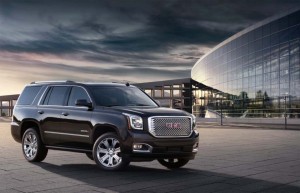
Fuel economy is at an all-time high partially due to the fact that full-size trucks and SUVs are getting better gas mileage than ever.
With retail sales of new vehicles by traditional fuel economy leaders, such as Toyota and Honda, on the upswing, the fuel-economy of new vehicles sold in the U.S. reached an all-time high in August, a new report from the University of Michigan Transportation Institute (UMTRI) indicates.
Average fuel economy (window-sticker values) of cars, light trucks, vans and sport utility vehicles purchased in August was 24.9 mpg – up 0.1 mpg from July, according to UMTRI researchers Michael Sivak and Brandon Schoettle.
Overall, gas mileage is up 4.8 mpg since October 2007 when UMTRI began keeping track of fuel-economy numbers.
The price of gasoline has been relatively stable with prices averaging between $3.65 per gallon to $3.70 per gallon, according to the latest reported from the federal Energy Information Agency.
While truck and sport utility vehicles have posted strong sales this year, sales of small cars, hybrids and diesels, which boost the average fuel figures, also have been climbing. In addition, new models, including new trucks, get better fuel economy than the vehicles they replace and Asian carmakers with reputations for good fuel economy have been picking up market share in recent months.
Fuel economy of model-year 2013 vehicles sold since October 2012 is 24.7 mpg, up 1.2 mpg from 2012 models.
The study’s average sales-weighted fuel economy was calculated by UMTRI from the monthly sales of individual models of light-duty vehicles (cars, SUVs, vans, and pickup trucks) and the combined city/highway fuel-economy ratings published in the EPA Fuel Economy Guide (i.e., window sticker ratings) for the respective models. For both monthly and model year averages, sales-weighted arithmetic means were calculated.
(GM’s new full-size SUVs expected to post best mpg ever. For more, Click Here.)
Sivak and Schoettle also expect average to improve again during the 2014 model year as manufacturers continue to boost fuel economy on new models in the fact of rising federal standards.
In addition to average fuel economy, Sivak and Schoettle also publish a monthly update of UMTRI’s national Eco-Driving Index, which estimates the average monthly emissions generated by an individual U.S. driver. The EDI takes into account both the fuel used per distance driven and the amount of driving – the latter relying on data that are published with a two-month lag.
(Click Here to see how the EPA will change mileage testing.)
During June, the EDI held steady at 0.81 for the second straight month (the lower the value, the better). The index currently shows that emissions of greenhouse gases per driver of newly purchased vehicles are down 19%, overall, since October 2007.

The auto makers have no choice as they try to meet the absurd Obama and EPA mandated 54.5 mpg, which they will not be able to do unless consumers by millions of EVs every single year from now until eternity – which ain’t going to happen.